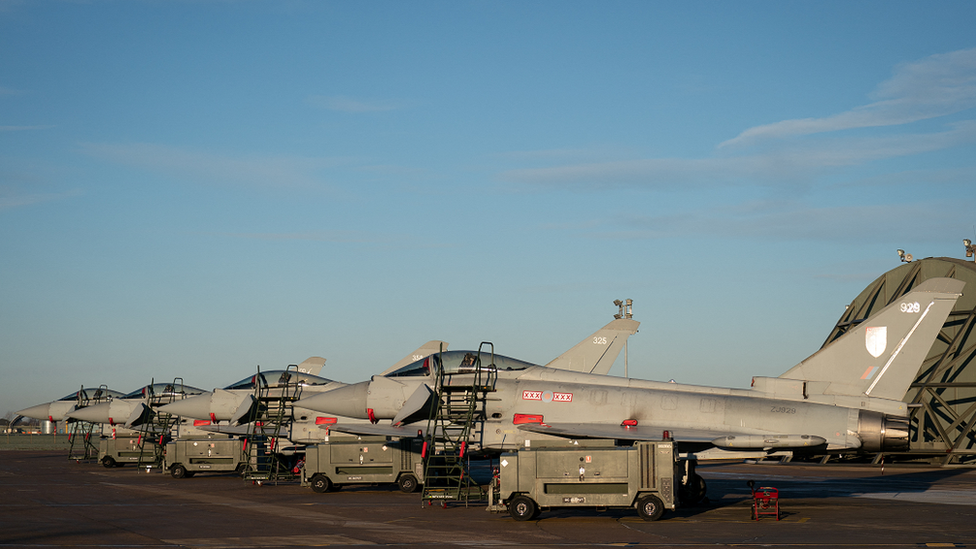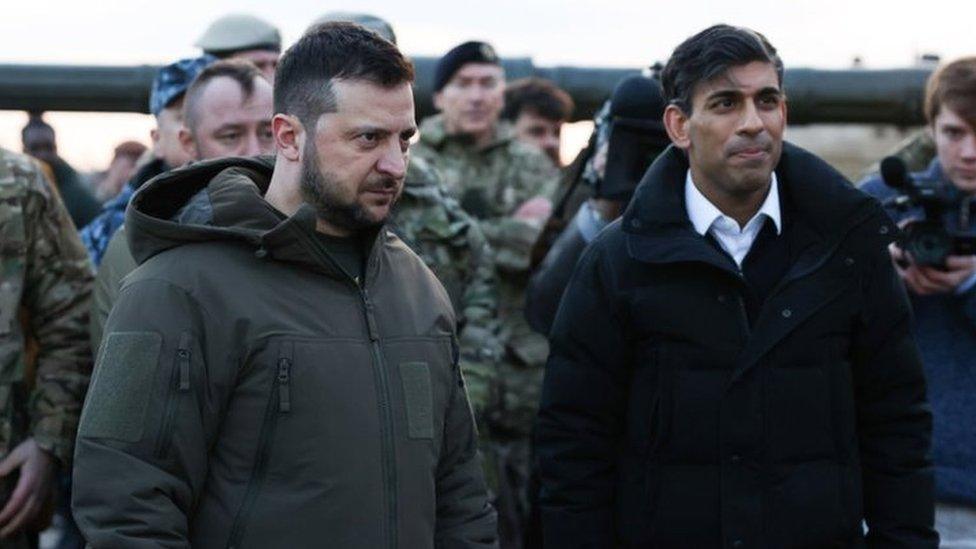Ukraine: No immediate transfer of UK fighter jets - Wallace
- Published
- comments

Typhoons at RAF Coningsby in Lincolnshire
There will be no immediate transfer of UK fighter jets to Ukraine, the defence secretary has said.
Ukrainian President Volodymr Zelensky renewed his call for fighter jets during a visit to the UK on Wednesday - his first since the Russian invasion.
Ben Wallace told the BBC that supplying aircraft to use in the conflict would potentially take months.
The defence secretary said the UK was instead focused on using alternative provision of air cover to Ukraine.
Mr Wallace did not completely rule out sending aircraft to Ukraine, but said air support and supporting moving troops could be achieved by using long-range missiles and drones.
Speaking at a conference in Rome, he said it was "more realistic and more productive" to envisage the UK providing Ukraine with aircraft in the long-term to ensure its security after the war with Russia has ended.
"This is not a simple case of towing an aircraft to the border," Mr Wallace told the BBC.
"Britain knows what Ukraine needs and is very happy to help in many ways trying to achieve the effect.
"Those same effects can be done, but potentially through a different way - and without taking months, which of course gifting fighter jets would take."
The first step to providing Ukraine with aircraft is training their pilots, says Rishi Sunak
UK Prime Minister Rishi Sunak said he was discussing further support for Ukraine which potentially included fighter jets, but the first step was training Ukrainian pilots and the UK is to start doing this on Nato-standard aircraft.
The defence secretary dismissed suggestions made by former prime minister Boris Johnson that the UK could provide 100 Typhoon warplanes. Typhoons are made by a coalition of different countries and their permission would be needed before sending them on to Ukraine, he said.
Mr Wallace said he had a duty to ensure the UK and Nato had the aircraft needed for their own defence.
The UK's existing commitments, including air policing in the Baltic states and a squadron of Typhoons in Qatar, means there are not many jets left to spare.
There are also large practicality issues including the training of pilots - which would take time even for those with combat experience.
Around 20 of the oldest Typhoons are due to be retired in 2025.
Mr Wallace added that the Typhoons which would most likely be supplied are only equipped for air to air combat, and not suitable for ground attack.
The American F-16 is seen as the fighter jet which would be most suitable for Ukraine.
President Zelensky addressed the European Parliament in Brussels on Thursday morning and is expected to ask EU leaders for more weaponry and fighter jets later.
Some EU leaders are keen to avoid having the debate on fighter jets being played out in public, while there is also concern about escalation and playing into Russian narratives.
The Kremlin warned on Thursday that the line between direct and indirect Western involvement in the conflict was disappearing.
Earlier this year, the UK announced it would send 14 battle tanks to Ukraine.

What support has the UK given Ukraine?
Since Russia invaded in February last year, the UK has spent £2.3bn on military assistance, making the country the second biggest donor behind the US. The government has said it plans to match this spending again this year.
The UK has also imposed a series of financial sanctions on Russia and taken over 100,000 Ukrainian refugees.
Military equipment provided so far includes:
Several air defence systems, including Starstreak, designed to bring down low-flying aircraft at short range.
Challenger 2 tanks
Artillery including 30 AS90 self propelled artillery guns
Hundreds of thousands of rounds of 155mm ammo
M270 multiple-launch rocket systems with M31A1 precision munitions
Next-generation light anti-tank weapons, or Nlaw
Maritime Brimstone missiles
Armoured vehicles, including Mastiff patrol vehicles
Heavy lift unmanned aerial vehicle (UAV) systems to provide logistical support to isolated force
Electronic warfare equipment

Additional reporting by James Gregory, BBC News
Related topics
- Published8 February 2023

- Published9 February 2023
